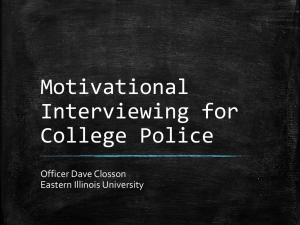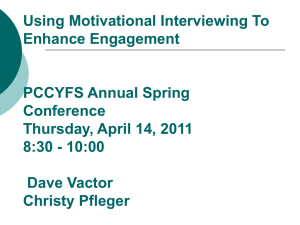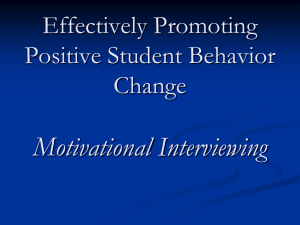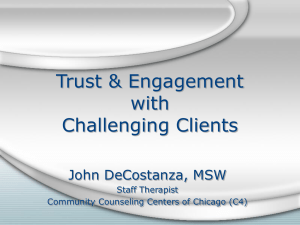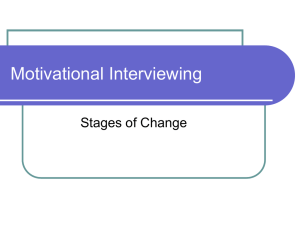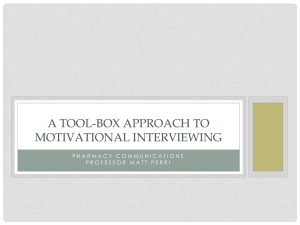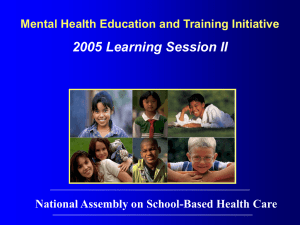Critical components - Motivational Interviewing
advertisement
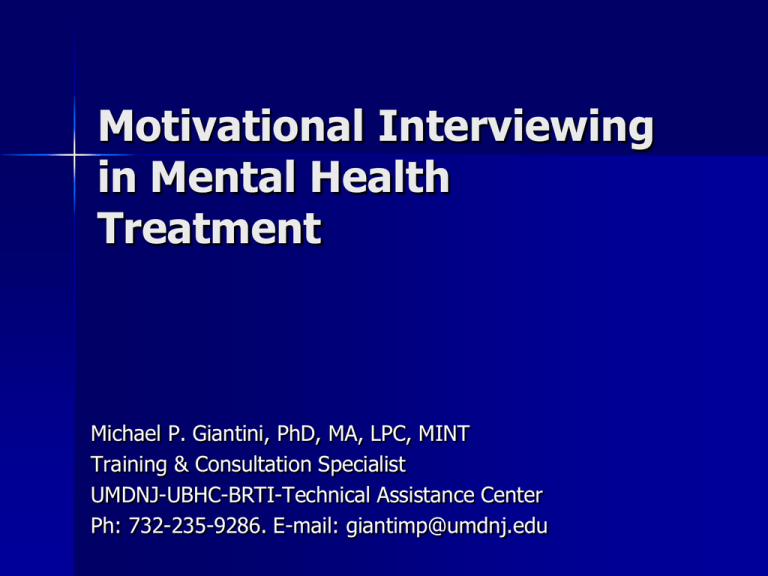
Motivational Interviewing in Mental Health Treatment Michael P. Giantini, PhD, MA, LPC, MINT Training & Consultation Specialist UMDNJ-UBHC-BRTI-Technical Assistance Center Ph: 732-235-9286. E-mail: giantimp@umdnj.edu References ‘Motivational Interviewing’ 2nd Edition, Miller & Rollnick, 2002, Guilford Press ‘Evidence-based Mental Health Practice’, Drake et.al., 2005, Norton Ohio Substance Abuse & Mental Health Coordinating Center of Excellence: http://www.ohiosamiccoe.cwru.edu/about/abo utus.html Outline Core IDDT & MI principles Implementation: – Evaluating implementation and obstacles – Learning IDDT & MI – Evaluating fidelity and outcomes Motivational Interventions Specific approaches are designed to treat consumers in pre-action stages Motivational interventions: – Pre-contemplation – Contemplation – Preparation – Action = Counseling stage. Attempts to do counseling with clients who are pre/contemplators leads to poor results MI Spirit & its Mirror Collaboration Evocation Autonomy Confrontation &/or Directive Education Authority Principles of MI Roll with ‘resistance’ Express accurate empathy – particularly through reflective listening Develop discrepancy Support self-efficacy MI ‘micro-skills’ Affirmations Reflective listening Open-ended questions Summarizing Elicit change talk – OARS = open-ended questions, affirmations, reflective listening & summarizing Rogerian Skill and Client Outcomes Valle (1981) J Studies on Alcohol 42: 783-790 40 35 30 25 Client Relapse 20 Rates 15 10 5 0 38 35 29 24 23 20 19 15 13 18 11 5 6 Months 12 Months 18 Months 24 Months Follow-up Points Low Medium High Summary of 26 Co-occurring SPMI & SU Research Studies Drake et.al, Psychosocial Rehab. 12/2004 Integration of treatment is essential: – Non-integrated = <5% stable remission/year – Integrated = 10-20% stable remission/year Programs studied show positive outcomes: – < Substance abuse, psychiatric symptoms, hospitalizations & arrests – > Housing, functional status and quality of life Critical components across programs identified Currently 36 controlled studies provide empirical evidence for approach Critical components: 1. Integrated treatment The same clinicians or team of clinicians provide treatment for symptoms of mental illness and substance use disorders at the same time. The team integrates all aspects of the treatment and has the same philosophy and clinical approach to treatment. Critical components: 2. Assertive Outreach Clients have difficulty linking with services and treatment Engages clients & members of their support system Without assertive outreach, noncompliance and dropout rates are high Part of Engagement Stage of Treatment Critical components: 3. Counseling Multiple modalities: – Use of Motivational Interviewing & Cognitive Behavioral Therapy – Individual – Group Persuasion and Active/Relapse Prevention Social Skills and Skills training Co-occurring disorders specific groups – Family Family Psycho-education for Co-DOs Behavioral Family Therapy Counseling – Motivational Interviewing is integrated into all the different counseling approaches before and during counseling sessions – Specific substance abuse counseling – Interventions to reduce negative consequences – Secondary interventions for substance abuse treatment ‘non-responders’ – Social support interventions: Strengthening of immediate social environment Includes social network as well as family interventions May include abstinent/sober and/or overall recovery supports Critical components: 4. Long-term Perspective Long-term community based perspective that includes (re)-habilitation perspective Consumers tend to NOT develop stability and functional improvements even in intensive treatment programs unless they enter treatment at an active stage (active treatment and motivated) 10%-20% maximum remission/year Longitudinal studies indicate 1 to 8 years Critical components: 5. Comprehensiveness Attention to substance use and mental illness is integrated into all aspects of existing mental health program including: – Inpatient hospitalization, all outpatient and assertive community treatments, residential services, medical care, assessment, crises intervention, medication management, money management, laboratory screening, housing & vocational rehabilitation. Comprehensiveness Inclusion of other EBPs – Assertive community treatment or Integrated Case Management – Residential services – Illness management and recovery – Supported employment – Family Psychoeducation Critical components: 6. Cultural Competence Need for tailoring of programs to address under-served groups Model program generalization: – Local solutions are not necessarily superior – Cultural and local considerations are important but critical program components need to be replicated to achieve good outcomes Critical components: 7. Staged Interventions Intensive treatment approaches do not work for the majority of consumers High drop out rates related to mismatch in stage of change Stages of Treatment & Change – Engagement – Persuasion -> -> – Active treatment – Relapse prevention -> -> Pre-contemplation Contemplation & Preparation Action Maintenance Past Year Perceived Need for Specialty Treatment among Persons Aged 12 or Older Needing Treatment for Alcohol/Illicit Drugs: 2003 National Survey on Drug Use & Health Not Treated and Did Not Feel They Needed Treatment (19.3 Million) 87% 5% Not Treated and Did Feel They Needed Treatment (1.0 Million) (26% Made Effort to Get Treatment) 8% Treated (1.9 Million Receiving Treatment) 22.2 Million Needing Treatment for Illicit Drugs or Alcohol Past Year Receipt of and Perceived Need for Treatment for Mental Health Problems among Persons Aged 18 or Older with SMI: 2003 NSDU&H Treated (9.2 Million) 47% 13% 40% 19.6 Million with SMI Not Treated, Perceived Unmet Need (2.5 Million) Not Treated, No Perceived Unmet Need (7.8 Million) Past Year Treatment among Adults Aged 18 or Older with Co-Occurring SMI and a Substance Use Disorder: 2003 NSDU&H Treatment Only for Mental Health Problems Treatment for Both Mental Health and Substance Use Problems 39.8% 7.5% 3.7% No Treatment Substance Use Treatment Only 49.0% (4.2) Million Adults with Active Co-Occurring SMI and Substance Use Disorder Transtheoretical Change Process HOW PEOPLE CHANGE Maintenance Precontemplation Action Contemplation Preparation/Planning Matching Stage of Change, SATS & Types of Interventions Stage of Change Precontemplation SATS Engagement Interventions IDDT methods Outreach, practical health, crisis intervention, relationship building, assessment CRS; SATS, Longitudinal Assessment; Contextual Assessment; Payoff Matrix/Functional Analysis; Motivational Interviewing Contemplation Persuasion & preparation Education, goal setting, increase awareness of problems practical skills training, family support, peer support Motivational interviewing (expressing empathy, developing discrepancy, eliciting change talk, rolling with resistance, supporting self-efficacy) Action Active Substance abuse counseling, medications treatment, skills training, self-help, groups, family therapy Functional analysis, skills training Maintenance Relapse prevention Relapse prevention plan, continuing skill training, expanding recovery to other areas Continuation of functional analysis, skills training, specific relapse prevention plans Critical components: 8. Motivational Interventions Most consumers initially have low motivation for abstinence-oriented treatment and/or management of psychiatric illness and other functional goals Elicit clients own goals and support for them. Consumers in pre-action stage are identifiable MI is an EBP (> 105 clinical trials) Practical considerations exercise Form groups of similar roles: – – – – Administrative Supervisory Clinical/case management Consumer/family member Consider: – Core EBP (intervention) principles – What would be the pros and cons for your agency to implement one of these practices (time, QI, costs, staff & agency stages of change)? – What would you see as necessary to implement the practice?

